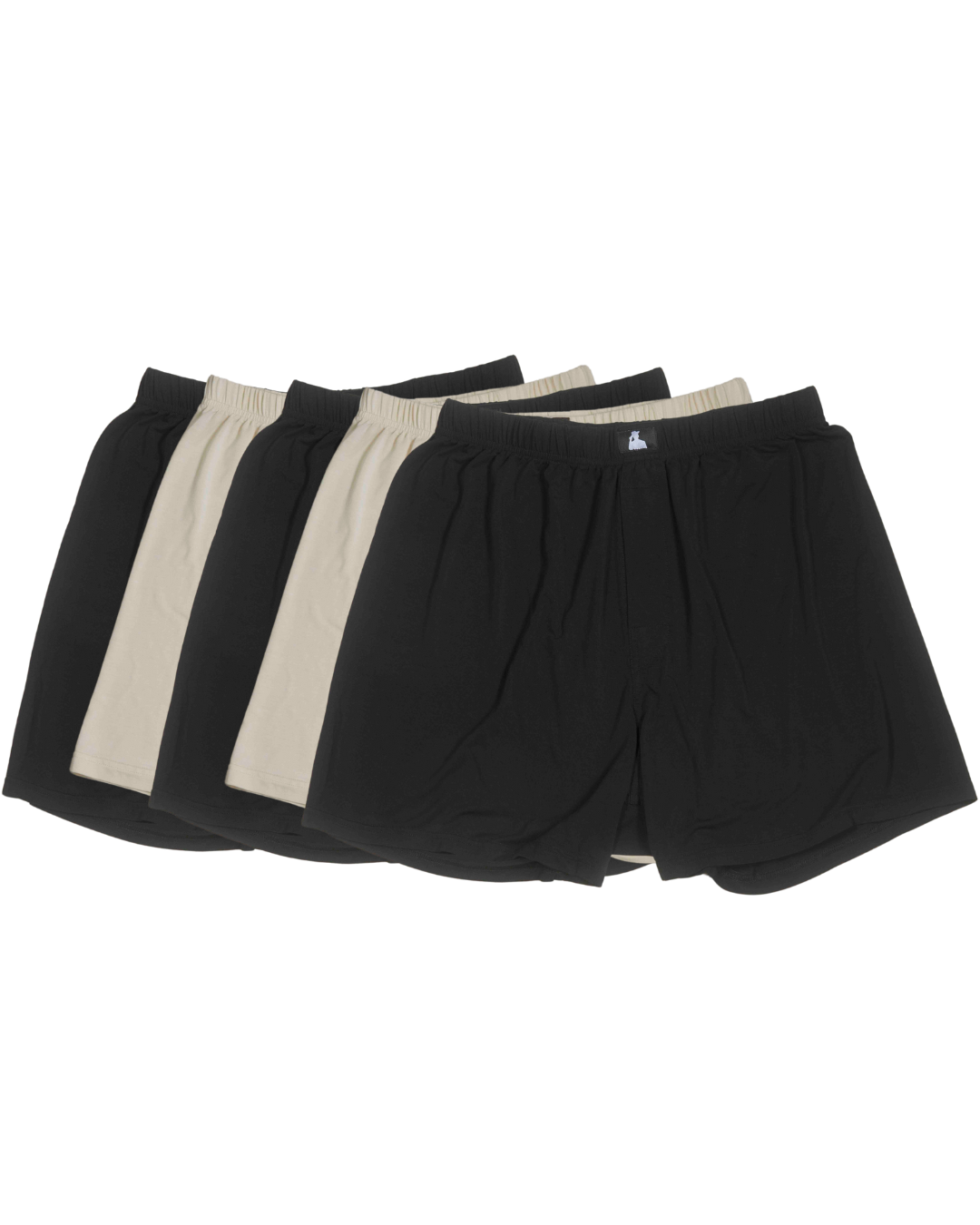Safe Underwear for Sensitive Skin: What to Look For (and What to Avoid)
Written By The Mr. Fertyl Research & Education Team
Choosing the right underwear is more than a comfort issue – it can directly affect your skin’s health and even your long-term wellness. If you have sensitive skin, you’ve likely experienced how the wrong fabric or chemicals in clothing can trigger irritation. Men who are health-conscious (especially those mindful of fertility) also have extra incentive to avoid materials that might introduce toxins or overheat the groin area. The good news is that by understanding what to avoid and what to look for in underwear, you can protect your skin and health. Below, we break down the key factors in finding truly safe underwear for sensitive skin, and highlight why options like Mr. Fertyl’s Bamboo Lyocell underwear are gaining attention for their skin- and fertility-friendly design.
What to Avoid: Irritating Fabrics and Hidden Chemicals
1. Synthetic Fabrics (Polyester, Nylon, etc.): Underwear made from synthetic fibers like polyester and nylon can be problematic for sensitive skin. These materials tend to trap heat and moisture, creating a sweaty, irritating microclimate that can lead to rashes or itching [3][5]. In some people, prolonged contact with polyester even triggers contact dermatitis – a red, itchy allergic reaction [11]. Synthetics are less breathable than natural fibers, so they allow sweat and bacteria to build up, which is bad news for skin comfort and hygiene [1]. Moreover, synthetic garments often contain chemical additives from manufacturing that can leach out. For example, some people develop allergies to the formaldehyde resins used in synthetic or wrinkle-resistant clothes [3][4]. If you have sensitive skin, it’s wise to avoid underwear made entirely of non-breathable synthetics. (A small amount of spandex for stretch is usually fine, but the base fabric should be safe.)
2. Chemically Treated Cotton: Cotton itself is usually gentle on skin, but be cautious with “no-iron” or wrinkle-free cotton shirts and underwear. These often rely on formaldehyde treatments to prevent wrinkles [2][9]. Formaldehyde is a known skin irritant that can cause allergic rashes, and it’s even classified as a carcinogen (cancer-causing substance) [2]. Regular cotton underwear may also harbor residues of pesticides or bleaches if it’s not organic. Over time and washes these residues diminish, but initially they could aggravate very sensitive skin.
3. Harsh Dyes and Colorants: That fun pair of bright-red underwear might be harboring harsh dyes. Synthetic textile dyes (especially azo dyes and dyes containing para-phenylenediamine, or PPD) are a hidden trigger for many people’s skin irritation [2][9]. Dermatologists actually see clothing dye allergies quite often – for instance, chronic rashes on the legs can turn out to be an allergy to the dye in black pants [4]. If you have extra-sensitive skin, consider sticking to white or light-colored underwear without heavy dyes, or look for brands that use natural, non-toxic dyes. This reduces the risk of allergic reactions [1].
4. Rough or Allergic Elastic Components: The design of the underwear matters too. Elastic waistbands and leg openings can irritate if they’re too tight, have abrasive edges, or contain allergy-triggering materials. For example, some elastics contain latex or rubber accelerators, which are common allergens that can cause contact dermatitis where the band touches your skin [9]. If you have a latex allergy or get red marks from elastic, look for underwear labeled “latex-free” or those with covered waistbands. Seam tags and rough stitching can also scratch sensitive skin, so many people prefer tag-free, flat-seamed designs [3]. The goal is to minimize any scratchy or irritating friction points on the garment.
5. “Performance” Finishes with Hidden Toxins: Be wary of underwear marketed as “anti-odor,” “moisture-proof,” or “stain-resistant.” These high-tech finishes can introduce a slew of chemical additives. For instance, “anti-odor” or antimicrobial fabrics may be treated with agents like triclosan or nanosilver, which can disrupt hormones and even affect your skin microbiome [2]. “Stain-resistant” or water-repellent finishes often use PFAS (per- and polyfluoroalkyl substances), a group of chemicals linked to immune system and developmental problems [2]. Such chemicals earned nicknames like “forever chemicals” because they persist in the environment and in our bodies. Over time, exposure through clothing can add to your body’s chemical burden. In fact, health experts note that PFAS in textiles and other plastic additives act as endocrine disruptors – they interfere with hormones and have been associated with reproductive issues like lower sperm quality and fertility problems [2][6]. For a fertility-conscious man, avoiding these hidden toxins is a smart move. Tip: Check clothing labels for terms like “wrinkle-free,” or “stain-resistant” – these often signal chemical treatments [2]. Whenever possible, choose simpler, untreated fabrics for the peace of mind that you’re not exposing your skin (or testes) to unnecessary chemicals.
6. Environmental Red Flags: It’s worth noting that many of the materials and finishes above don’t just affect your skin – they can also impact the environment, which circles back to health. Synthetic fibers shed microplastics with every wash and wear; these tiny plastic particles can penetrate the skin barrier and have been shown to provoke inflammation and disturb skin’s natural balance [7]. Those same microplastics eventually enter waterways, causing broader environmental contamination. Toxic fabric treatments (like dyes, formaldehyde, and PFAS) can similarly leach out and pollute water and air during manufacturing and washing [2][6]. By avoiding heavily synthetic or chemically saturated underwear, you’re not only being kind to your skin but also reducing your ecological footprint.

Heat Hurts Fertility
Shop Mr. FertylWhat to Look For: Gentle, Breathable, and Non-Toxic Options
Now that we’ve covered what to dodge, let’s spotlight safer underwear choices that will keep your skin calm and healthy. The ideal underwear for sensitive skin (and general wellness) should be: breathable, free of harsh chemicals, and designed for comfort. Here are the top things to look for:
- Natural, Breathable Fabrics: Dermatologists often recommend sticking with natural fibers for everyday undergarments.
- Bamboo Lyocell and Other Eco-Friendly Fabrics: A newer all-star fabric for sensitive skin is Bamboo Lyocell – the material Mr. Fertyl proudly uses in its underwear line. Bamboo-based fabrics are impressing many experts because they check a lot of boxes: they’re ultra-soft, highly breathable, and naturally moisture-wicking [5]. In fact, Bamboo Lyocell can absorb significantly more moisture than cotton – up to 3 times its weight in water – which means it excels at keeping your skin dry and cool. This helps prevent the salty sweat residue and overheating that can set off eczema or rashes in sensitive areas [5]. Bamboo fiber also has a smooth, round structure that translates to less friction on the skin, so it won’t chafe or rough up irritated patches. And as a bonus, bamboo fabrics are often touted as naturally antibacterial or odor-resistant; studies have found that bamboo textiles can inhibit bacterial growth (even after many washes) [5], which is great for keeping things fresh downstairs. What’s special about Bamboo Lyocell? Not all bamboo fabric is created equal. Standard bamboo “viscose” is made with a chemically-intensive process that isn’t very environmentally friendly and could leave trace chemical residues [5]. Bamboo Lyocell, on the other hand, is produced via a closed-loop process that uses a non-toxic solvent and recycles almost 100% of that solvent [5]. This means you get the benefits of bamboo (softness, absorbency, gentleness) without the hefty chemical footprint. Mr. Fertyl’s Bamboo Lyocell underwear is a prime example – it’s OEKO-TEX® certified to contain no harmful substances, so you know no formaldehyde, phthalates, or heavy metals are lurking in the fabric. The lyocell process also makes the fabric ultra-pure and safe for sensitive skin, while being much kinder to the planet. It’s truly a win-win: you’re choosing a fabric that soothes your skin now and supports a healthier environment (and body) in the long run [5].
- Organic or Dye-Free Choices: Organic fabrics are grown and processed without the toxic pesticides, bleaches, or finishing agents that can irritate skin. Also consider opting for undyed (natural color) or light-colored underwear, especially if you’ve had past reactions. Some brands use fiber-reactive or plant-based dyes which are generally safer; Mr. Fertyl, for example, avoids harsh synthetic dyes in their bamboo line. Keeping it simple and natural minimizes your exposure to potential irritants.
- Comfort-Focused Design: Little design details can make a big difference when you have sensitive skin. Look for underwear that has flat seams or seam-free sides to prevent rubbing. A tagless label (printed information instead of a sewn tag) means nothing will scratch your back. Ensure the waistband is soft and covered: some high-quality underwear encase the elastic in a soft fabric sheath so it doesn’t dig into your skin. If you know you’re allergic to latex or rubber, seek out underwear advertised as latex-free. (There are specialty brands and even allergy-friendly lines that use latex-free elastic or drawstring waists [9].) The fit should be snug enough to support but not too tight – you want breathability. Particularly for men, looser-fitting styles (like boxers or relaxed boxer-briefs) can help keep the groin cooler. Cooler temperatures are actually better for male fertility, since the testicles function optimally a few degrees below body heat [10]. Overly tight, non-breathable underwear could raise temperatures and potentially impact sperm quality over time. So, a comfortable fit isn’t just good for skin, it’s good for “the boys” as well.
- Fertility-Friendly Features: For men concerned about fertility and overall reproductive health, combining all the qualities above is key. You want breathable, toxin-free, and supportive underwear. Materials that are free from hormone-disrupting chemicals (like BPA, phthalates, and heavy metals) remove one potential risk factor – you don’t need unwanted substances in constant contact with such an important area of the body. Mr. Fertyl’s underwear line was designed with exactly this in mind: using Bamboo Lyocell fabric that contains no endocrine disruptors, and engineering the fit to promote airflow. The Bamboo Lyocell is light and temperature-regulating, which helps avoid warming the testes (something that can reduce sperm count if prolonged) [10][12]. Plus, by being supremely soft and moisture-wicking, it reduces any chance of chafing or infections that could indirectly affect sexual health. In short, fertility-focused men don’t have to sacrifice comfort or style – you can wear underwear that supports your goals (literally and figuratively).

Breathe Better. Feel Better.
Stay Cool with Mr. FertylFinal Thoughts
Empowerment through choice – that’s what this all comes down to. Our most sensitive skin areas deserve fabrics and products that care for them, not challenge them. By avoiding the cheap synthetics and chemical-laden finishes that might be fine for the average person (but can spell disaster for sensitive skin), you’re putting your comfort and health first. And by choosing high-quality, natural alternatives – like organic cotton or innovative Bamboo Lyocell – you’re investing in underwear that feels good and does good.
For those with sensitive skin, the difference is often night and day: breathable, irritant-free underwear means no more constant itch or irritation, and far fewer surprise rashes. For those with broader health concerns, it means peace of mind that you’re not exposing yourself to hidden hazards every day. Little changes (like switching your underwear fabric) can have a surprisingly large impact on your daily well-being.
As you revamp your drawer, remember that safe underwear can still be stylish and sustainable. Mr. Fertyl’s Bamboo Lyocell line exemplifies this, proving that you can have eco-friendly, skin-friendly, and fertility-friendly underwear all in one. By knowing what to look for (soft, natural fibers and non-toxic design) and what to avoid (plasticky fabrics and chemical additives), you’re now equipped to make informed choices. Your sensitive skin will thank you, and you can feel good knowing you’re protecting more than just your skin – you’re also guarding your long-term health and even the environment. That’s a wardrobe upgrade that truly matters.
- Cleveland Clinic. (2025, March 19). 5 Underwear Tips To Avoid Problems Down There. Source.
- University Hospitals. (2025, May 22). Do Your Child’s Clothing, Bedding and Mattress Have Toxic Chemicals? Source.
- Lillis, C. (2024, May 24). Fabrics for eczema: Best, worst, and how to clean. Medical News Today. Source.
- American Academy of Dermatology. (2020, December 15). Itchy rash could be contact dermatitis. Source.
- National Eczema Society. (n.d.). Clothing and eczema. Source.
- Endocrine Society. (2020, December 10). Plastics, EDCs & Health: Authoritative Guide. Source.
- Aristizabal, M. et al. (2024). Microplastics in dermatology: Potential effects on skin homeostasis. Journal of Cosmetic Dermatology, 23(3), 766-772. Source.
- Shafik, A. (1993). Effect of different types of textile fabric on spermatogenesis: An experimental study. Urological Research, 21(5), 367-370. Source.
- DermNet NZ. (2013). Textile contact dermatitis. Source.
- Mayo Clinic Health System. (2019, March 1). Boxers or briefs? 4 common fertility myths debunked. Source.
- Kandola, A. (2023, July 26). Polyester allergy: Symptoms, treatment, and prevention. Medical News Today. Source.
- Jung, A., Leonhardt, F., Schill, W. B., & Schuppe, H.-C. (2005). Influence of the type of undertrousers and physical activity on scrotal temperature. Human Reproduction, 20(4), 1022–1027. Source.

